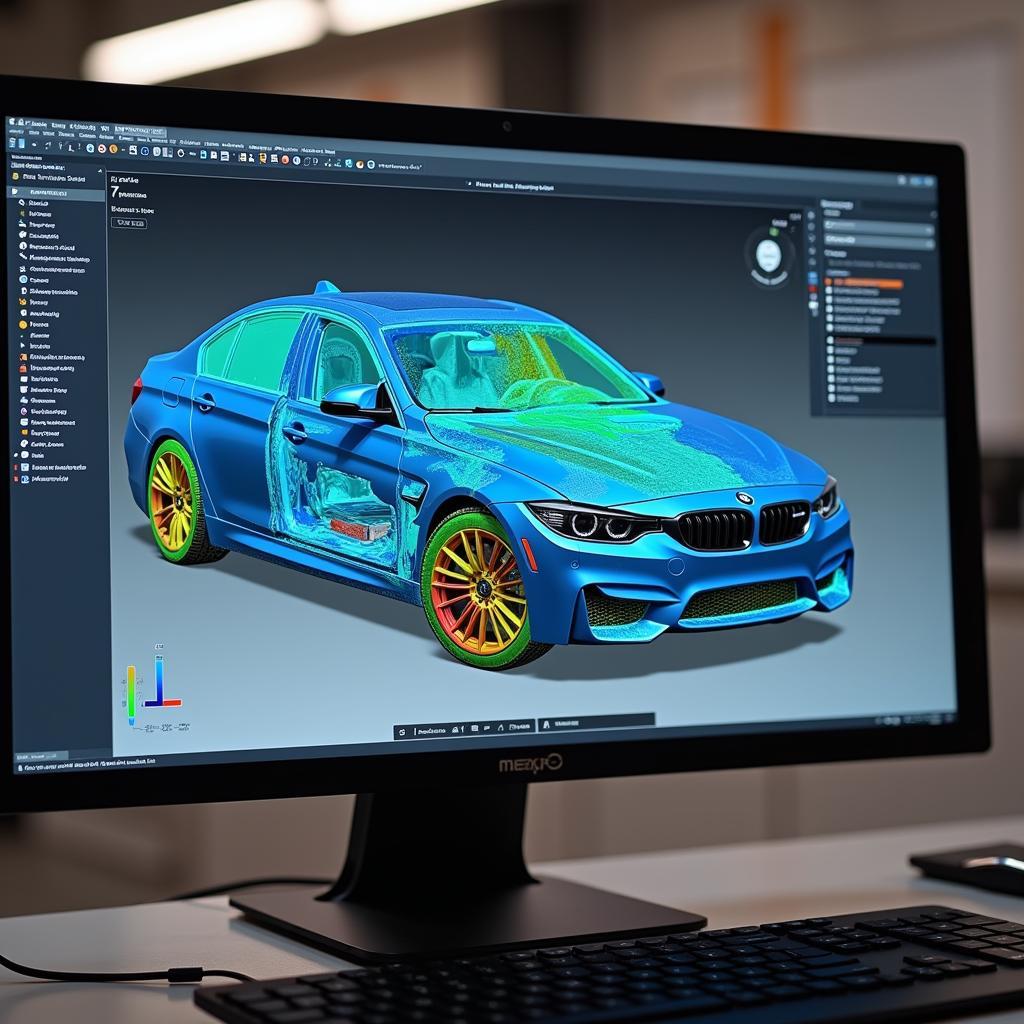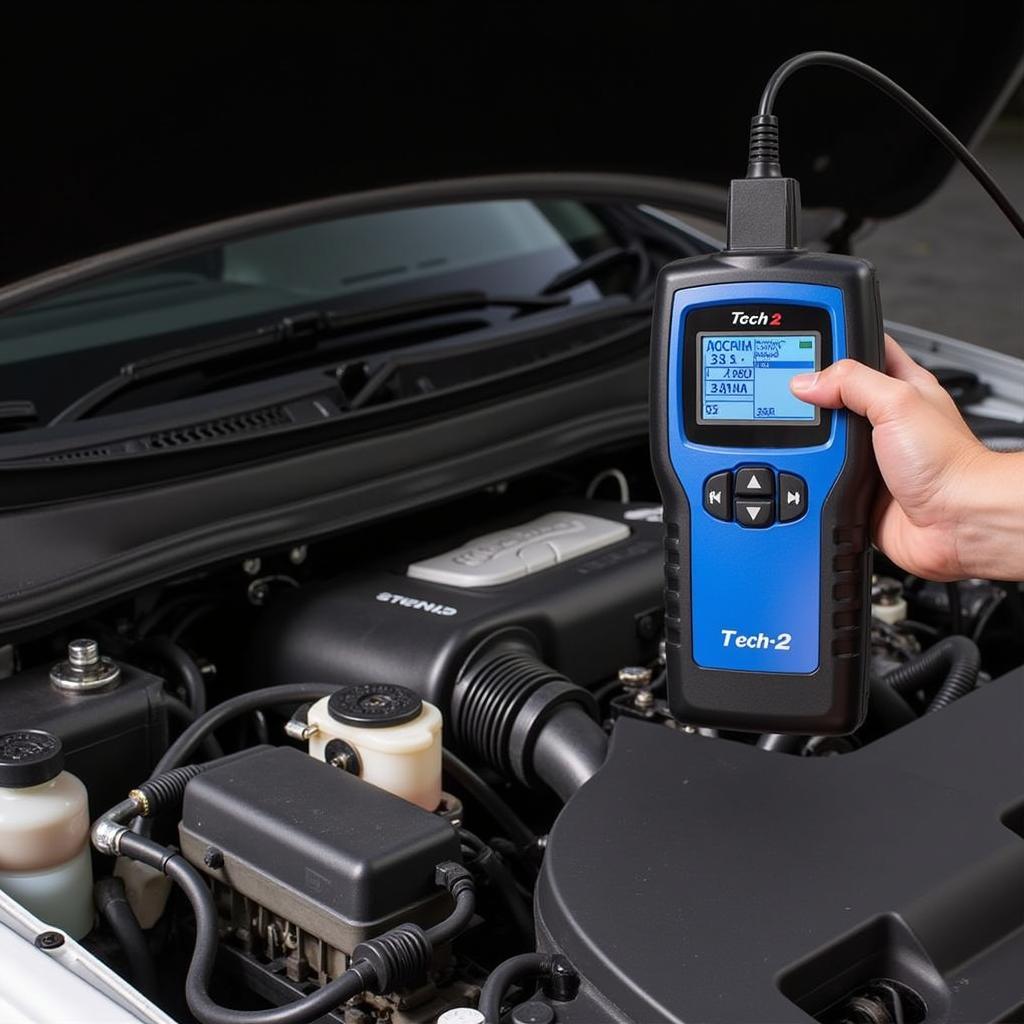The check engine light is on, and you have no idea what’s wrong. Taking your car to a mechanic can be expensive and time-consuming. A DIY automotive scan tool empowers you to diagnose and potentially fix car problems yourself. But with so many options on the market, how do you choose the Best Diy Automotive Scan Tool for your needs? This guide will walk you through everything you need to know.
[image-1|best-diy-automotive-scan-tool-options|Mechanic using a DIY scan tool to diagnose a car problem|A mechanic is shown plugging a scan tool into a car’s OBD-II port, with the scan tool displaying diagnostic information on its screen. The image highlights the ease and effectiveness of using a DIY scan tool for car diagnostics.]
Understanding OBD-II and Diagnostic Trouble Codes (DTCs)
Before diving into scan tools, it’s essential to understand how your car communicates problems. All cars manufactured after 1996 have an OBD-II (On-Board Diagnostics II) port. Think of this as your car’s data center. When the check engine light illuminates, it’s because the car’s computer has detected a problem and stored a corresponding Diagnostic Trouble Code (DTC). An automotive scan tool reads these DTCs, allowing you to decipher what’s happening under the hood.
[image-2|obd-ii-port-location-in-car|Location of the OBD-II port in a car| The image shows the interior of a car with the OBD-II port highlighted. It is usually located under the dashboard on the driver’s side.]
Types of DIY Automotive Scan Tools
There’s a scan tool for every skill level and budget:
1. Basic Code Readers: These affordable tools read and clear basic DTCs. They are a great starting point for beginners.
2. Advanced OBD-II Scanners: These offer more features than basic code readers, including the ability to view live data streams, freeze frame data, and oxygen sensor readings.
3. Professional Scan Tools: These are the most expensive and comprehensive tools, offering advanced functionalities such as bidirectional control (sending commands to car components) and access to manufacturer-specific systems.
Choosing the Right Scan Tool: Factors to Consider
Navigating the world of automotive scan tools can feel like learning a new language. Here’s what to consider:
1. Your Budget: Prices range from affordable for basic code readers to several hundred dollars for advanced models. Determine your budget and prioritize the features you need.
2. Your Skill Level: If you’re just starting, a basic code reader might suffice. For more experienced DIYers, an advanced OBD-II scanner offers greater diagnostic capabilities.
3. Vehicle Compatibility: Ensure the scan tool you choose is compatible with your car’s make, model, and year.
4. Features: Consider what features you need. Live data streaming, ABS (Anti-lock Brake System) diagnostics, and airbag system access can be invaluable for certain repairs.
5. User Interface: Choose a scan tool with a user-friendly interface and clear display. Some models offer Bluetooth connectivity, allowing you to view data on your smartphone.
[image-3|diy-mechanic-using-scan-tool-on-smartphone|A DIY mechanic using a scan tool connected to his smartphone.|The image shows a mechanic using a scan tool that wirelessly transmits data to a smartphone app, illustrating the convenience of modern scan tools.]
Don’t hesitate to explore resources like the automotive scan tool forum for insights and recommendations.
Benefits of Owning a DIY Automotive Scan Tool
Investing in the best DIY automotive scan tool offers numerous benefits:
- Save Money: Avoid costly mechanic visits for simple diagnostics.
- Empowerment: Take control of your car’s maintenance and repairs.
- Early Detection: Identify potential problems early, preventing costly repairs down the line.
- Improved Resale Value: Regular maintenance documented with a scan tool can increase your car’s resale value.
- Peace of Mind: Drive with confidence knowing you have a tool to help diagnose unexpected issues.
Common Uses for DIY Automotive Scan Tools
A DIY automotive scan tool is more than just a code reader; it’s a versatile tool with numerous applications:
- Diagnosing Check Engine Light: The most common use is reading and clearing DTCs that trigger the check engine light.
- Monitoring Engine Performance: Analyze live data streams for RPM, coolant temperature, oxygen sensor readings, and more.
- Troubleshooting Sensor Issues: Identify faulty sensors such as mass airflow sensors or oxygen sensors.
- Resetting Service Lights: Reset oil change reminders and other service lights after completing maintenance.
- Verifying Repairs: After making repairs, use the scan tool to confirm that the issue is resolved.
[image-4|mechanic-using-scan-tool-to-check-engine-performance|Mechanic using a scan tool to analyze engine performance metrics.|The image displays a mechanic using a scan tool connected to a car. The scan tool screen is visible, showing various engine performance parameters being monitored in real time.]
Tips for Using Your DIY Automotive Scan Tool
- Read Your Vehicle’s Manual: Familiarize yourself with your car’s specific OBD-II system and potential DTCs.
- Start with a Clear Code: Before diagnosing, clear any existing codes to ensure you’re addressing the current problem.
- Research Codes Thoroughly: Don’t panic when you see a code. Research its meaning and potential causes.
- Utilize Online Resources: Websites and forums dedicated to your car model can provide valuable insights. Check out resources like what is a good obd scan tool for additional information.
- Don’t Hesitate to Seek Professional Help: If you encounter a complex issue or are unsure about a repair, consult a qualified mechanic.
Conclusion: Empowering DIY Car Maintenance
A DIY automotive scan tool is an essential tool for any car owner looking to take control of their vehicle’s maintenance. By understanding how to choose the right scan tool and interpret the information it provides, you can diagnose car problems, save money on repairs, and drive with greater confidence.
If you are ready to explore a wide range of DIY automotive scan tools, you can find a variety of options at where to buy a car diagnostic scanner.
Need help choosing the right scan tool for your needs? Contact ScanToolUS at +1 (641) 206-8880 or visit our office at 1615 S Laramie Ave, Cicero, IL 60804, USA. We’re here to help you diagnose your car like a pro!
FAQs
1. Can I use a DIY scan tool on any car?
While all cars made after 1996 have an OBD-II port, scan tool compatibility can vary. It’s essential to choose a scan tool that is compatible with your car’s make, model, and year.
2. Can I use a DIY scan tool to diagnose transmission problems?
Yes, many advanced DIY automotive scan tools can access and diagnose transmission codes. You can find out if AutoZone carries a specific scan tool for transmissions by visiting does auto zone have a scan tool for transmisions.
3. What is the difference between “live data” and “freeze frame data?”
“Live data” refers to real-time information from your car’s sensors, while “freeze frame data” captures sensor readings at the moment a DTC is stored.
4. Can I damage my car by using a DIY automotive scan tool?
As long as you use the scan tool correctly and follow instructions, you are unlikely to damage your vehicle.
5. Do I need to be mechanically inclined to use a DIY automotive scan tool?
Basic scan tool operation is relatively straightforward. However, some diagnostic and repair procedures may require mechanical knowledge.



Pingback: Car Scan Tool AutoZone: Your Guide to DIY Diagnostics - Car Scan Tool
Pingback: Best DIY Auto Scan Tool: Diagnose Car Problems Like a Pro - Car Scan Tool